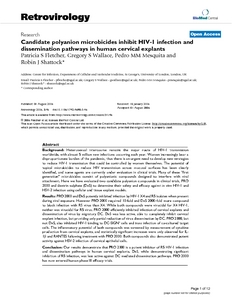Fletcher, PS; Wallace, GS; Mesquita, PM; Shattock, RJ
(2006)
Candidate polyanion microbicides inhibit HIV-1 infection and dissemination pathways in human cervical explants.
RETROVIROLOGY, 3 (46).
ISSN 1742-4690
https://doi.org/10.1186/1742-4690-3-46
SGUL Authors: Shattock, Robin John
![[img]](https://openaccess.sgul.ac.uk/1267/1.hassmallThumbnailVersion/1742-4690-3-46.pdf)  Preview |
|
["document_typename_application/pdf; charset=binary" not defined]
Published Version
Download (763kB)
| Preview
|
Abstract
BACKGROUND: Heterosexual intercourse remains the major route of HIV-1 transmission worldwide, with almost 5 million new infections occurring each year. Women increasingly bear a disproportionate burden of the pandemic, thus there is an urgent need to develop new strategies to reduce HIV-1 transmission that could be controlled by women themselves. The potential of topical microbicides to reduce HIV transmission across mucosal surfaces has been clearly identified, and some agents are currently under evaluation in clinical trials. Many of these "first generation" microbicides consist of polyanionic compounds designed to interfere with viral attachment. Here we have evaluated two candidate polyanion compounds in clinical trials, PRO 2000 and dextrin sulphate (DxS) to determine their safety and efficacy against in vitro HIV-1 and HSV-2 infection using cellular and tissue explant models.
RESULTS: PRO 2000 and DxS potently inhibited infection by HIV-1 X4 and R5 isolates when present during viral exposure. However PRO 2000 required 10-fold and DxS 2000-fold more compound to block infection with R5 virus than X4. While both compounds were virucidal for X4 HIV-1, neither was virucidal for R5 virus. PRO 2000 efficiently inhibited infection of cervical explants and dissemination of virus by migratory DC. DxS was less active, able to completely inhibit cervical explant infection, but providing only partial reduction of virus dissemination by DC. PRO 2000, but not DxS, also inhibited HIV-1 binding to DC-SIGN+ cells and trans infection of co-cultured target cells. The inflammatory potential of both compounds was screened by measurement of cytokine production from cervical explants, and statistically significant increases were only observed for IL-1beta and RANTES following treatment with PRO 2000. Both compounds also demonstrated potent activity against HSV-2 infection of cervical epithelial cells.
CONCLUSION: Our results demonstrate that PRO 2000 is a potent inhibitor of R5 HIV-1 infection and dissemination pathways in human cervical explants. DxS, while demonstrating significant inhibition of R5 infection, was less active against DC mediated dissemination pathways. PRO 2000 has now entered human phase III efficacy trials.
| Item Type: |
Article
|
| Additional Information: |
© 2006 Fletcher et al; licensee BioMed Central Ltd.
This is an Open Access article distributed under the terms of the Creative Commons Attribution License (http://creativecommons.org/licenses/by/2.0), which permits unrestricted use, distribution, and reproduction in any medium, provided the original work is properly cited. |
| Keywords: |
Animals, Anti-HIV Agents, Cell Adhesion Molecules, Cercopithecus aethiops, Cervix Uteri, Cytokines, Dextrins, Female, HIV Infections, HIV-1, Humans, Lectins, C-Type, Naphthalenesulfonates, Polymers, Receptors, Cell Surface, Receptors, HIV, Sulfates, Vero Cells, Science & Technology, Life Sciences & Biomedicine, Virology, HUMAN-IMMUNODEFICIENCY-VIRUS, HERPES-SIMPLEX-VIRUS, SULFATED POLYSACCHARIDES, TOPICAL MICROBICIDES, IN-VITRO, TYPE-1 INFECTION, DENDRITIC CELLS, PRO-2000 GEL, TRANSMISSION, PREVENTION |
| Journal or Publication Title: |
RETROVIROLOGY |
| ISSN: |
1742-4690 |
| Related URLs: |
|
| Dates: |
| Date | Event |
|---|
| 1 August 2006 | Published |
|
| Web of Science ID: |
WOS:000241189000001 |
  |
Download EPMC Full text (PDF)
|
 |
Download EPMC Full text (HTML)
|
| URI: |
https://openaccess.sgul.ac.uk/id/eprint/1267 |
| Publisher's version: |
https://doi.org/10.1186/1742-4690-3-46 |
Statistics
Item downloaded times since 30 Apr 2012.
Actions (login required)
 |
Edit Item |



